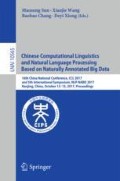Abstract
This paper proposes a novel end-to-end neural model to jointly extract entities and relations in a sentence. Unlike most existing approaches, the proposed model uses a hybrid neural network to automatically learn sentence features and does not rely on any Natural Language Processing (NLP) tools, such as dependency parser. Our model is further capable of modeling multiple relations and their corresponding entity pairs simultaneously. Experiments on the CoNLL04 dataset demonstrate that our model using only word embeddings as input features achieves state-of-the-art performance.
Access this chapter
Tax calculation will be finalised at checkout
Purchases are for personal use only
Notes
- 1.
The above example contains one relation and three entities, and these entities will form three entity pairs (or six entity pairs if the direction of relation is considered).
- 2.
conll04.corp at cogcomp.cs.illinois.edu/page/resource_view/43.
- 3.
References
Gupta, P., Schutze, H., Andrassy, B.: Table filling multi-task recurrent neural network for joint entity and relation extraction. In: COLING (2016)
Hinton, G.E., Srivastava, N., Krizhevsky, A., Sutskever, I., Salakhutdinov, R.R.: Improving neural networks by preventing co-adaptation of feature detectors. Comput. Sci. 3(4), 212–223 (2012)
Hochreiter, S., Schmidhuber, J.: Long short-term memory. Neural Comput. 9(8), 1735–1780 (1997)
Huang, Z., Xu, W., Yu, K.: Bidirectional LSTM-CRF models for sequence tagging. Comput. Sci. (2015)
Kalchbrenner, N., Grefenstette, E., Blunsom, P.: A convolutional neural network for modelling sentences. In: ACL (2014)
Kate, R.J., Mooney, R.J.: Joint entity and relation extraction using card-pyramid parsing. In: ACL (2010)
Kumar, A., Irsoy, O., Ondruska, P., Iyyer, M., Bradbury, J., Gulrajani, I., Zhong, V., Paulus, R., Socher, R.: Ask me anything: dynamic memory networks for natural language processing. Comput. Sci. (2016)
Lample, G., Ballesteros, M., Subramanian, S., Kawakami, K., Dyer, C.: Neural architectures for named entity recognition. In: NAACL-HLT, pp. 260–270 (2016)
Li, Q., Ji, H.: Incremental joint extraction of entity mentions and relations. In: ACL, pp. 402–412 (2014)
Mikolov, T., Sutskever, I., Chen, K., Corrado, G., Dean, J.: Distributed representations of words and phrases and their compositionality. In: NIPS (2013)
Miwa, M., Bansal, M.: End-to-end relation extraction using LSTMs on sequences and tree structures. In: ACL, pp. 1105–1116 (2016)
Miwa, M., Sasaki, Y.: Modeling joint entity and relation extraction with table representation. In: EMNLP, pp. 944–948 (2014)
Roth, D., Yih, W.: A linear programming formulation for global inference in natural language tasks. Technical report, DTIC Document (2004)
Santos, C.N.D., Xiang, B., Zhou, B.: Classifying relations by ranking with convolutional neural networks. Comput. Sci. (2015)
Schuster, M., Paliwal, K.K.: Bidirectional recurrent neural networks. IEEE Trans. Signal Process. 45(11), 2673–2681 (1997)
Shin, J., Wu, S., Wang, F., De Sa, C., Zhang, C., Ré, C.: Incremental knowledge base construction using deepdive. VLDB Endowm. 8(11), 1310–1321 (2015)
Singh, S., Riedel, S., Martin, B., Zheng, J., Mccallum, A.: Joint inference of entities, relations, and coreference. In: The Workshop on Automated Knowledge Base Construction, pp. 1–6 (2013)
Suchanek, F.M., Ifrim, G., Weikum, G.: Combining linguistic and statistical analysis to extract relations from web documents. In: SIGKDD, pp. 712–717 (2006)
Vu, N.T., Adel, H., Gupta, P., et al.: Combining recurrent and convolutional neural networks for relation classification. In: NAACL-HLT, pp. 534–539 (2016)
Yang, B., Cardie, C.: Joint inference for fine-grained opinion extraction. In: ACL, pp. 1640–1649 (2013)
Yao, L., Sun, C., Li, S., Wang, X., Wang, X.: CRF-based active learning for Chinese named entity recognition. In: IEEE International Conference on Systems, Man and Cybernetics, pp. 1557–1561 (2009)
Zeiler, M.D.: ADADELTA: an adaptive learning rate method. Comput. Sci. (2012)
Zelenko, D., Aone, C., Richardella, A.: Kernel methods for relation extraction. J. Mach. Learn. Res. 3(3), 1083–1106 (2010)
Zeng, D., Liu, K., Lai, S., Zhou, G., Zhao, J., et al.: Relation classification via convolutional deep neural network. In: COLING, pp. 2335–2344 (2014)
Zhang, D., Wang, D.: Relation classification via recurrent neural network. Comput. Sci. (2015)
Zheng, S., Hao, Y., Lu, D., Bao, H., Xu, J., Hao, H., Xu, B.: Joint entity and relation extraction based on a hybrid neural network. Neurocomputing (2017)
Acknowledgments
This research was supported by the National High Technology Research and Development Program of China (No. 2015AA015402) and the National Natural Science Foundation of China (No. 61602479). We thank the anonymous reviewers for their insightful comments.
Author information
Authors and Affiliations
Corresponding author
Editor information
Editors and Affiliations
Rights and permissions
Copyright information
© 2017 Springer International Publishing AG
About this paper
Cite this paper
Zhou, P., Zheng, S., Xu, J., Qi, Z., Bao, H., Xu, B. (2017). Joint Extraction of Multiple Relations and Entities by Using a Hybrid Neural Network. In: Sun, M., Wang, X., Chang, B., Xiong, D. (eds) Chinese Computational Linguistics and Natural Language Processing Based on Naturally Annotated Big Data. NLP-NABD CCL 2017 2017. Lecture Notes in Computer Science(), vol 10565. Springer, Cham. https://doi.org/10.1007/978-3-319-69005-6_12
Download citation
DOI: https://doi.org/10.1007/978-3-319-69005-6_12
Published:
Publisher Name: Springer, Cham
Print ISBN: 978-3-319-69004-9
Online ISBN: 978-3-319-69005-6
eBook Packages: Computer ScienceComputer Science (R0)

